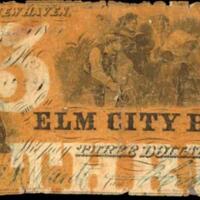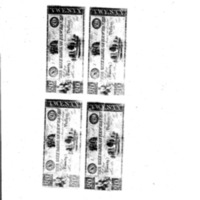New Haven, Connecticut - Elm City Bank - $3 1863 - with the Seropyan's Patent yellow tint
Reference Description
New Haven, Connecticut. Elm City Bank. January 1, 1863.3. (CT-275 G6a).
Notes
Christopher Ter Seropyan: The Man Behind the Green Ink of the US Dollar
Introduction:
Christopher Ter Seropyan, a chemist and pharmacist of Armenian origin, made a significant impact on the history of the United States currency. His invention of a special green ink for the U.S. dollar bill made counterfeiting more difficult and resulted in the iconic green color that is now synonymous with the American dollar. This essay delves into the life and achievements of Ter Seropyan and the story behind his innovative creation.
Early Life and Background:
Christopher Ter Seropyan was born in the 19th century in Istanbul, during a time when the world was undergoing rapid technological advancements. As a young man, he pursued his passion for chemistry and eventually made his way to the United States, where he was invited to apply his skills to a pressing problem: the counterfeiting of U.S. banknotes.
The Counterfeiting Problem and the Green Ink Solution:
During the 1860s, the rapid development of photography presented counterfeiters with an opportunity to easily reproduce black and white banknotes. The United States government recognized the need for a new approach to protect its currency and its citizens from these fraudulent activities. Ter Seropyan was entrusted with the task of developing an ink that could not be forged, leading to the creation of the unique green ink used on U.S. dollar bills.
Ter Seropyan's method of using a green ink made from organic or metallic substances that could reflect or transmit the chemical rays of light was groundbreaking at the time. The innovative ink, when combined with specially designed oil-colored paper, provided a level of protection against counterfeiting techniques such as photography, lithographic stone transferring, and anastatic printing. This combination of green ink and oil-colored paper became the foundation for the now-famous "greenbacks."
Later Life and Legacy:
For his invaluable contribution to the security of the U.S. currency, Ter Seropyan was rewarded with $6,000, which he used to further his studies in the field of pharmacy. Eventually, he returned to Istanbul and continued to work as a pharmacist. Despite his significant impact on the U.S. economy and the history of its currency, Ter Seropyan remains a relatively unknown figure today.
In conclusion, Christopher Ter Seropyan was a pioneering chemist whose innovative green ink forever changed the face of the U.S. dollar. His invention not only enhanced the security of the American currency but also left a lasting visual legacy that continues to represent the United States in the global economy. Ter Seropyan's story serves as a testament to the power of innovation and the indelible mark that an individual can leave on history.
Introduction:
Christopher Ter Seropyan, a chemist and pharmacist of Armenian origin, made a significant impact on the history of the United States currency. His invention of a special green ink for the U.S. dollar bill made counterfeiting more difficult and resulted in the iconic green color that is now synonymous with the American dollar. This essay delves into the life and achievements of Ter Seropyan and the story behind his innovative creation.
Early Life and Background:
Christopher Ter Seropyan was born in the 19th century in Istanbul, during a time when the world was undergoing rapid technological advancements. As a young man, he pursued his passion for chemistry and eventually made his way to the United States, where he was invited to apply his skills to a pressing problem: the counterfeiting of U.S. banknotes.
The Counterfeiting Problem and the Green Ink Solution:
During the 1860s, the rapid development of photography presented counterfeiters with an opportunity to easily reproduce black and white banknotes. The United States government recognized the need for a new approach to protect its currency and its citizens from these fraudulent activities. Ter Seropyan was entrusted with the task of developing an ink that could not be forged, leading to the creation of the unique green ink used on U.S. dollar bills.
Ter Seropyan's method of using a green ink made from organic or metallic substances that could reflect or transmit the chemical rays of light was groundbreaking at the time. The innovative ink, when combined with specially designed oil-colored paper, provided a level of protection against counterfeiting techniques such as photography, lithographic stone transferring, and anastatic printing. This combination of green ink and oil-colored paper became the foundation for the now-famous "greenbacks."
Later Life and Legacy:
For his invaluable contribution to the security of the U.S. currency, Ter Seropyan was rewarded with $6,000, which he used to further his studies in the field of pharmacy. Eventually, he returned to Istanbul and continued to work as a pharmacist. Despite his significant impact on the U.S. economy and the history of its currency, Ter Seropyan remains a relatively unknown figure today.
In conclusion, Christopher Ter Seropyan was a pioneering chemist whose innovative green ink forever changed the face of the U.S. dollar. His invention not only enhanced the security of the American currency but also left a lasting visual legacy that continues to represent the United States in the global economy. Ter Seropyan's story serves as a testament to the power of innovation and the indelible mark that an individual can leave on history.
Collection
Citation
“New Haven, Connecticut - Elm City Bank - $3 1863 - with the Seropyan's Patent yellow tint,” Armenian Numismatic Research Organization, accessed January 22, 2025, https://armnumres.org/items/show/1441.






